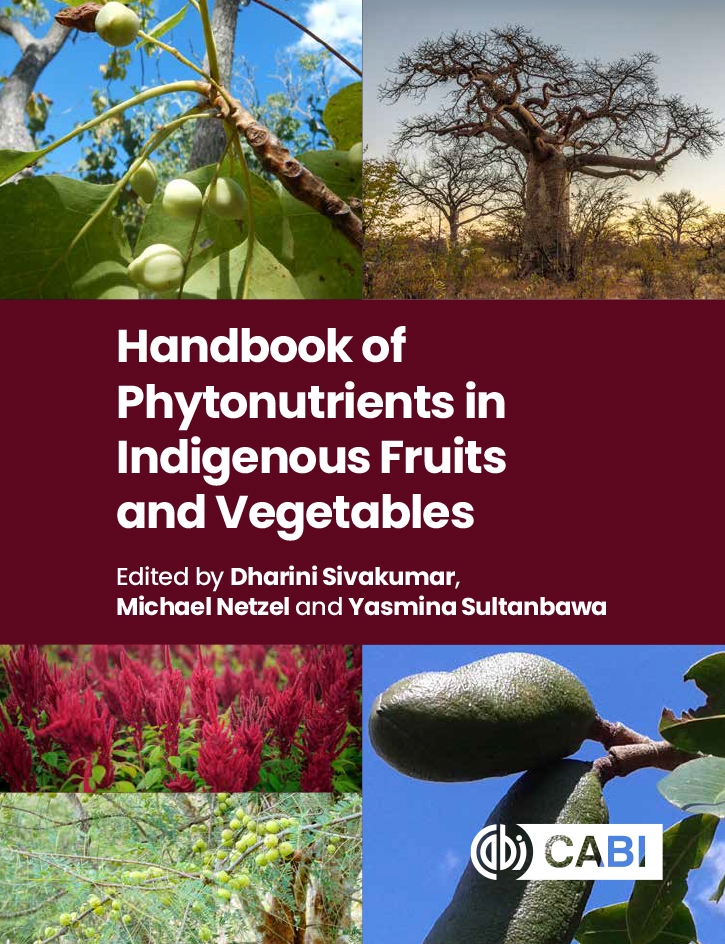This new publication, detailing Phytonutrients in Indigenous Fruits and Vegetables which is co-published by CABI and IFIS Publishing.
Authors
Dharini Sivakumar, Tshwane University of Technology, South Africa
Michael Netzel, The University of Queensland, Australia
Yasmina Sultanbawa, The University of Queensland, Australia
Handbook of Phytonutrients in Indigenous Fruits and Vegetables
synopsis
The effects of inadequate diets on the population include malnutrition, non-communicable diseases and obesity. 'Hidden hunger', also known as micronutrient deficiencies, leads to various health-related disorders and diseases. Indigenous plants, in the form of indigenous fruits and leafy vegetables are gaining interest as a source of nutrients and bioactive phytochemicals, satisfying both food demand and health needs.
Moreover, with the impact of climate change, and the importance of sustainability of food systems, it is essential that we investigate new, forgotten and alternative crops that can thrive in harsh conditions, require low fertilizer input, and are easily harvestable.
This book contains chapters on 33 understudied indigenous fruits and vegetables from all around the world, including African nightshade, amaranth, baobab fruit, Indian gooseberry, red bush apple and snake melon. Each chapter provides:
- An overview of plant botany.
- An understanding of the phytonutrient constituents and health-promoting properties of bioactive compounds or metabolites.
- Information on the biological activity of the functional compounds that will improve productivity and increase utilization of indigenous fruits and vegetables to sustain food security.
- Impacts of postharvest storage, processing, and traditional food preparation methods.
- Potential for new product development.
This is an essential resource for academic researchers and industry professionals in the fields of horticulture, agriculture, crop science, human health and nutrition.
Read this blog on 'Indigenous Fruit and Vegetables' written by Dharini Sivakumar and Yasmina Sultanbawa. Click below to read more
Table of contents
- Chapter 1: Salt bush (Atriplex spp.)
- Chapter 2: Gumby Gumby (Pittosporum Angustifolium)
- Chapter 3: Spider Plant (Cleome gynandra)
- Chapter 4: Amaranth (Genus Amaranthus)
- Chapter 5: African Pumpkin (Momordica balsamina)
- Chapter 6: Pumpkin leaves (Cucurbita maxima, Cucurbita moschata and Cucurbita pepo)
- Chapter 7: African Nightshade (Solanum nigrum complex species)
- Chapter 8: Moringa (Moringa oleifera)
- Chapter 9: Sweet Potato Leaves and its Role in Human Nutrition (Ipomoea batatas [L.] Lam)
- Chapter 10: Coral Tree (Erythrina variegata), an Indigenous Plant of Bangladesh
- Chapter 11: A Focus on Snake Melon: Agronomic Traits and Functional Quality of Snake Melon (Cucumis melo var. flexuosus)
- Chapter 12: Kakadu Plum (Terminalia ferdinandiana)
- Chapter 13: Lilly pilly/Riberry (Syzygium spp.)
- Chapter 14: Australian Green Plum (Buchanania obovata)
- Chapter 15: Red Bush Apple (Syzygium suborbiculare)
- Chapter 16: Passion Fruit (Passiflora edulis)
- Chapter 17: Baobab (Adansonia digitata L.)
- Chapter 18: Jatobá (Hymenaea courbaril L.) fruit
- Chapter 19: Ora-pro-nobis (Pereskia aculeata Miller) leaf and fruit
- Chapter 20: Bacupari Fruit (Garcinia brasiliensis Mart)
- Chapter 21: Monkey jack (Dewa) (Artocarpus lakoocha), an Indigenous fruit of Bangladesh
- Chapter 22: Black plum fruit (Vitex doniana)
- Chapter 23: Natal plum fruit (Carissa macrocarpa)
- Chapter 24: Brazilian Cherry (Eugenia uniflora L.)
- Chapter 25: Monkey Orange (Strychnos spinosa Lam)
- Chapter 26: African Star Apple (Chrysophyllum albidum)
- Chapter 27: Phalash (Grewia asiatica)
- Chapter 28: Phytonutrients of Mexican Plum (Spondias purpurea L.)
- Chapter 29: Phytonutrients of Soursop (Annona muricata)
- Chapter 30: Dabai (Canarium odontophyllum)
- Chapter 31: Mamey Sapote (Pouteria sapota (Jacq.)
- Chapter 32: Araçá Fruits (Psidium cattleianum Sabine)
- Chapter 33: Indian Goose Berry (Amla) (Phyllanthus emblica)
Pricing and order information
ePDF | ePDF 9781789248050 | £150.00 | €175.00 | $200.00
HARDCOVER | 9781789248043 | £150.00 | €175.00 | $200.00
UK, Europe and ROW: Visit www.cabi.org/bookshop
Or contact Marston Book Services Ltd, 160 Eastern Avenue, Milton Park, Abingdon, OX14 4SB, UK.
T: +44 (0)1235 465577 E: direct.orders@marston.co.uk
North and South America: Visit cab.presswarehouse.com
Or contact Stylus Publishing, Customer Services, PO Box 605, Herndon, VA 20172-0605, USA.
T: (703) 661-1581 or (800) 232-0223 E: StylusMail@PressWarehouse.com
About ifis
IFIS is a leading international provider of food and health information and produces FSTA® - Food Science and Technology Abstracts, a specialist database of content used by researchers, industry practitioners and students in the global food community, including free access for developing countries.
About CABI
CABI is an international not for profit organization based in the UK and a publisher of scientific, technical and medical material throughout the world. They use their surpluses to support scientific and rural development projects that help improve the lives of the world’s poorest people.


